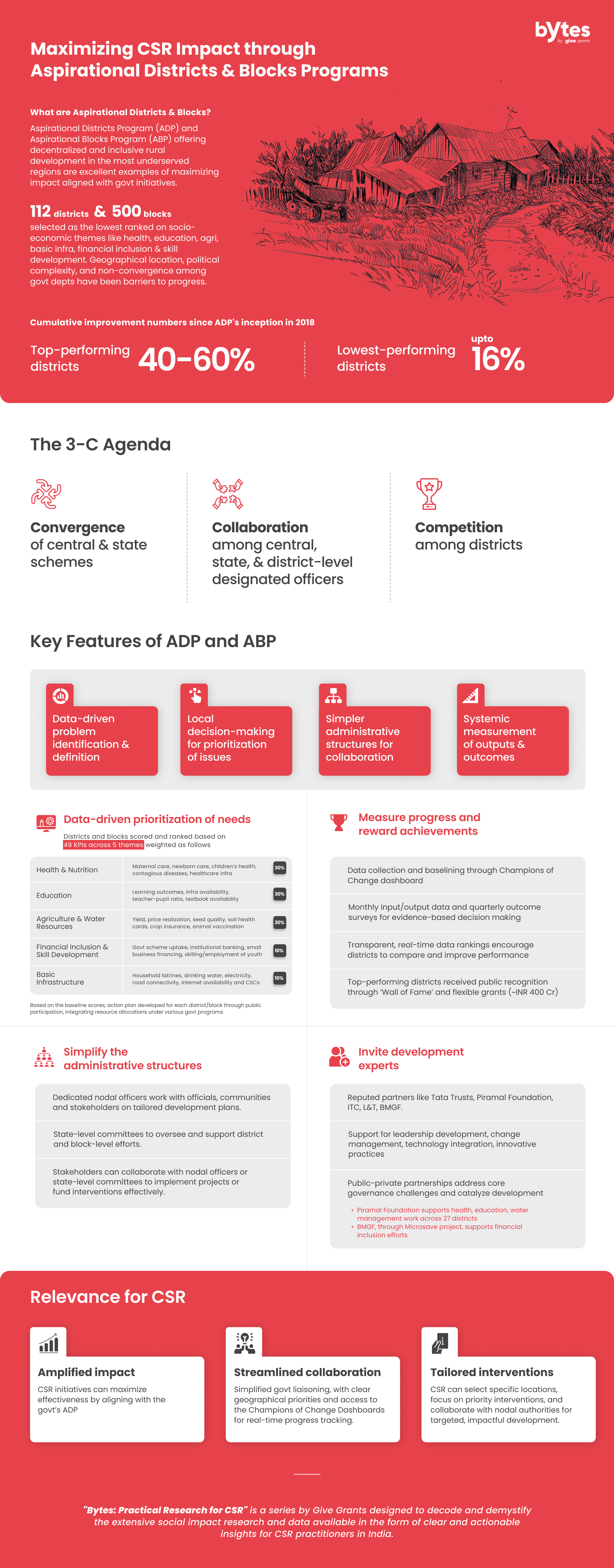

“Bytes: Practical Research for CSR” is a series by Give Grants designed to decode and demystify the extensive social impact research and data available in the form of clear and actionable insights for CSR practitioners in India.”
Annual CSR spending is 1.3% of annual government spending on social development, highlighting a significant opportunity for CSR grants to maximize their impact when aligned with government initiatives.[ref] The Aspirational Districts Program (ADP) and Aspirational Blocks Program (ABP) offering decentralized and inclusive rural development are excellent examples of such partnership opportunities.
What are Aspirational Districts and Blocks?

Key features of the program
The success of ADP can be attributed to several elements within the program's design. The program uses primary data to define problems, capacitates local self-governments to prioritize issues, creates simplified administrative structures to foster collaboration, and most importantly, regularly measures improvement.
Adopt data-driven prioritization of development needs
The 112 districts and 500 blocks are ranked based on their performance across five socio-economic themes, each broken down into key performance indicators:
Health and Nutrition (30%)
maternal care, newborn care, children’s health, contagious diseases, healthcare infrastructure.
Education (30%)
learning outcomes, infrastructural availability, and institutional indicators like teacher-pupil ratio, textbook availability.
Agriculture and Water Resources (20%)
yield, price realization, seed quality, soil health cards, and institutional support like crop insurance and animal vaccination.
Financial Inclusion and Skill Development (10%)
government scheme uptake, institutional banking, financing for small businesses, and skilling and employment of marginalized youth.
Basic Infrastructure (10%)
household latrines, drinking water, electricity and road connectivity, in addition to availability of internet connectivity and Common Service Centres in Panchayats.
This ranking exercise provides baseline data for these KPIs within each aspirational district and block. Based on this data, local self-governments can arrive at clear problem statements and set intended outcomes that would improve the ranking of their district or block.[ref] The district or block officials developed a Vision and Action Plan for 2018-22 through public participation, which integrates resource allocations under various central and state programs pertinent to the priority development areas of their respective geographies.[ref]
Measure progress and reward achievements
The data collection and baselining exercise has led to the Champions of Change dashboard, with independent dashboards for Aspirational Districts and Blocks. By systematically tracking progress and outcomes through specific indicators, the programs facilitate evidence-based decision-making, leading to more effective and sustainable development outcomes. Data on inputs and outputs are captured monthly, while outcomes are collected through quarterly surveys. Nodal officers on special duty oversee the process. Transparent, real-time rankings encourage districts to compare their performance with others. Top-performing districts were publicly recognized on a ‘Wall of Fame’ in December 2023,[ref] and 85 out of 112 districts received flexible grants totaling ~INR 400 Cr for specific projects as rewards for their improvements.[ref]
Simplify the administrative structures
Each district and block has a dedicated nodal officer collaborating closely with officials, communities, and stakeholders for tailored development plans. For both ADP and ABP, a state-level committee has also been established. Any stakeholder that wishes to implement a project or fund an intervention can work with either the nodal officer or the state-level committee to direct their efforts.
Invite development experts
The initiative is supported by prestigious partners in program implementation who provide ground-level support, such as Tata Trusts, Piramal Foundation, ITC, and L&T, as well as Bill & Melinda Gates Foundation to conduct surveys. These partners support the program through leadership development, change management, technology integration, and the implementation of various innovative practices. For example, the Piramal Foundation has deployed teams in 27 districts to support the administration in health, nutrition, education, and water resources management. Similarly, Microsave, a project supported by BMGF, has placed teams in districts to enhance financial inclusion. These efforts showcase the potential of public-private partnerships to address core governance challenges and catalyze development in India's most underdeveloped areas.[ref]
Relevance for CSR
Rural development projects can effectively leverage government support and amplify their impact if integrated with the Aspirational Districts and Blocks Programs. For the selected districts and blocks, geographical priorities have been identified, government liaisoning has been made easy, and the Champions of Change Dashboards provide status and progress documentation. A CSR initiative can choose a location of their interest, identify priority interventions across the key focus areas in conjunction with the designated nodal authority, and implement the program either with NGO partnership or by hiring vendors directly. By aligning with these programs, CSR leaders can maximize their impact, foster sustainable development, and contribute significantly to the socio-economic growth of India's most underdeveloped regions.
An overview of Aspirational Districts and Blocks Programs [Infographic]



